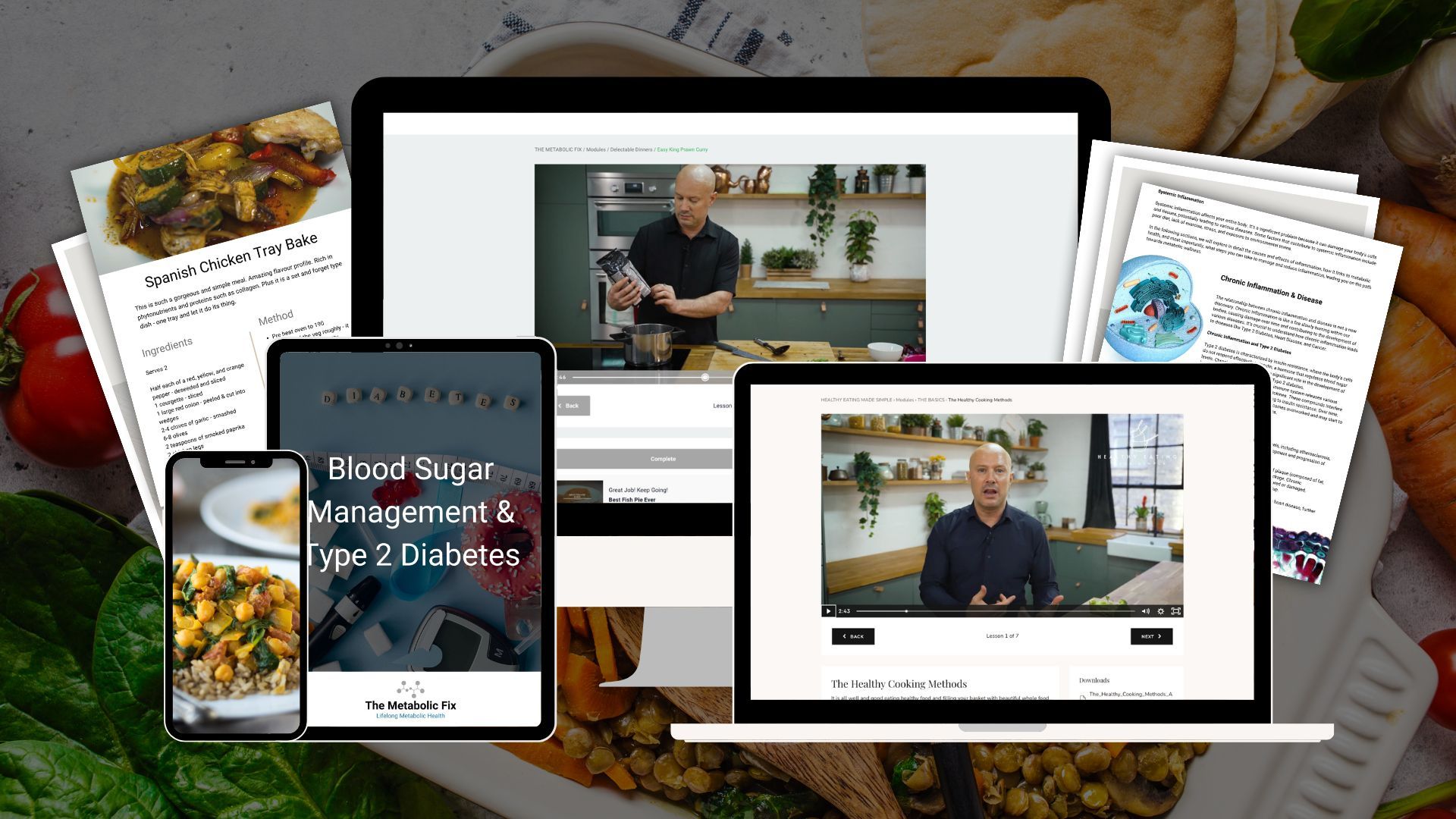The Perfect Plate: How to Build a Balanced, Type 2 Diabetes-Friendly Meal in No Time
Jul 06, 2023
Type 2 diabetes, a prevalent chronic condition affecting millions worldwide, requires careful management, with diet playing a crucial role. For those living with this condition, maintaining a balanced, nutritious diet is not merely a lifestyle choice; it is a pivotal aspect of their healthcare regimen. While the need for such a dietary regimen is widely recognised, the practicalities of implementing it in daily life can often be a challenge, particularly when time constraints are a factor.
Understanding Type 2 Diabetes
Type 2 diabetes is a chronic condition characterised by insulin resistance, a situation where the body's cells do not respond effectively to insulin - the hormone responsible for regulating blood sugar levels. This leads to elevated blood glucose levels, which, over time, can lead to severe complications such as cardiovascular disease, kidney disease, and nerve damage, among others.
A major factor contributing to the onset and progression of type 2 diabetes is diet. Poor dietary choices, especially those involving high intake of refined carbohydrates and unhealthy fats, can exacerbate insulin resistance, leading to increased blood sugar levels. On the flip side, a balanced, nutritious diet, which includes the right mix of complex carbohydrates, lean proteins, heart-healthy fats, and ample fiber, can help maintain blood glucose at optimal levels and manage the symptoms of type 2 diabetes.
Importantly, the management of type 2 diabetes is not simply about avoiding certain types of food; it's about embracing a comprehensive, sustainable approach to eating. The right diet can stabilise blood sugar levels, facilitate weight management, and promote overall health, which are all vital elements in living well with type 2 diabetes.
In the following sections, we will delve deeper into the constituents of a balanced, diabetes-friendly meal and provide practical guidance on how to incorporate such meals into your daily routine.
The Concept of a Balanced, Type 2 Diabetes-Friendly Meal
A balanced, type 2 diabetes-friendly meal is one that encompasses essential nutrients, helps maintain blood glucose levels, and supports overall health. It strikes a harmony among different food groups and prioritises quality over quantity.
The key components of such a meal include:
- Carbohydrates: These are the body's primary energy source. For individuals with type 2 diabetes, it's crucial to opt for complex carbohydrates over simple ones, as the former take longer to digest, resulting in a slower release of glucose into the bloodstream. Whole grains, legumes, fruits, and vegetables are excellent sources of complex carbohydrates.
- Proteins: Proteins are essential for cell repair and growth. They also help in satiety, making you feel full for longer, thereby preventing overeating. Opt for lean sources of protein like chicken, fish, tofu, and lentils to avoid excessive saturated fat.
- Fats: Not all fats are created equal. While saturated and trans fats can increase the risk of cardiovascular diseases - a common complication of diabetes - unsaturated fats can protect the heart. Include heart-healthy fats from avocados, nuts, seeds, and oily fish like salmon and mackerel in your diet.
- Fiber: Foods high in fiber can slow the absorption of sugar into your bloodstream and prevent spikes in blood glucose. Incorporate a variety of fiber-rich foods, such as whole grains, fruits, vegetables, and legumes, into your meals.
In addition to these components, portion control is an integral part of a balanced, diabetes-friendly meal. Overeating any food, healthy or otherwise, can lead to weight gain and higher blood sugar levels.
Understanding the constituents of a balanced meal is the first step in dietary management of type 2 diabetes. In the upcoming sections, we'll explore how to choose the right foods and how to plan and prepare meals that are not only quick and easy but also meet these criteria for balance and blood sugar control.
Food Choices and Meal Planning for Type 2 Diabetes
Strategising food choices and planning meals can significantly aid in managing type 2 diabetes. This involves understanding the nutritional composition of foods, choosing the right balance of nutrients, and adopting a consistent eating pattern.
- Carbohydrate Counting: Carbohydrates have the most significant impact on blood sugar levels, making it vital for individuals with type 2 diabetes to understand carbohydrate counting. This technique involves tracking the number of carbohydrates in grams or carbohydrate servings consumed at each meal or snack. The goal is to spread carbohydrate intake evenly throughout the day to prevent spikes and crashes in blood glucose levels.
- Low Glycemic Index Foods: The glycemic index (GI) is a tool that ranks foods based on how quickly they raise blood sugar levels. Foods with a low GI (55 or less) are digested more slowly, causing a slower and smaller rise in blood sugar. Examples include whole grains, non-starchy vegetables, some fruits, and legumes.
- Protein and Fat Choices: Lean proteins such as chicken, turkey, fish, eggs, tofu, and low-fat dairy products are great choices. They provide necessary nutrients without excessive saturated fat. Similarly, opting for unsaturated fats over saturated or trans fats can help maintain heart health. Avocados, nuts, seeds, and fish like salmon and mackerel are excellent sources of unsaturated fats.
- Dietary Fiber: Incorporating plenty of fiber in your diet is essential. It slows the rate at which sugar is absorbed into the bloodstream, helping to keep blood sugar levels more stable. Choose whole grains, legumes, fruits, and vegetables to boost your fiber intake.
- Hydration and Sensible Drink Choices: Staying hydrated is crucial. However, certain beverages can cause blood sugar spikes. Opt for water, unsweetened tea, or coffee, and avoid sugary drinks like sodas, juices, and energy drinks.
Following these guidelines, you can ensure your diet contains all the necessary nutrients, stays within your daily calorie target, and supports stable blood glucose levels. Remember, though, that everyone's body responds differently to different types of foods and diets, so it's important to monitor blood sugar levels before and after meals to understand how your body reacts to different foods. Consultation with a healthcare provider or a dietitian can also provide personalised guidance.
Steps to Build a Quick, Balanced, Type 2 Diabetes-Friendly Meal
The steps to creating a quick, balanced, type 2 diabetes-friendly meal do not differ drastically from creating a healthy meal for anyone else. The primary difference lies in being mindful of carbohydrate content and ensuring a balance of nutrients.
- Meal Preparation: Start by choosing your carbohydrates wisely. Select whole grains like brown rice, quinoa, or whole wheat bread. Then, pair it with a lean protein source like chicken, turkey, fish, or tofu. Round it off with a generous serving of non-starchy vegetables like leafy greens, bell peppers, or courgette. Add some heart-healthy fats from sources such as avocados, nuts, or seeds.
- Quick Meal Components: Pre-prepared salads and pre-cooked proteins can be real time-savers. Quick-cook grains like quinoa or couscous can also be cooked in advance and stored for use throughout the week. Ready-to-eat legumes such as canned beans or lentils are also excellent quick options that provide ample fiber and protein.
- Meal Diversity: Variety is essential, not only for the enjoyment of food but also for a balanced diet. Try to incorporate a diverse range of foods into your meals. Experiment with different cuisines, which can often offer unique, diabetes-friendly options. Take advantage of seasonal ingredients to add variety and freshness to your meals.
- Portion Control: Ensure that your portions align with your nutritional needs. As a general guideline, half of your plate should be non-starchy vegetables, a quarter lean protein, and the remaining quarter whole grains or other carbohydrate sources. Use measuring cups or a kitchen scale to get a sense of portion sizes.
These steps will help ensure that your meals are not just nutritious and diabetes-friendly, but also quick and easy to prepare. The key lies in planning ahead, making smart choices, and being mindful of portion sizes.
Examples of Quick, Balanced, Type 2 Diabetes-Friendly Meals
Let's put theory into practice with some examples of balanced meals suited for individuals with type 2 diabetes. Remember, these are just ideas to get you started; feel free to tweak them according to your personal preferences and nutritional needs.
- Breakfast: A nutritious breakfast could include a bowl of steel-cut oats prepared with unsweetened almond milk, sweetened with a sprinkle of cinnamon and topped with a handful of almonds and a serving of blueberries. This meal offers complex carbohydrates, lean protein, healthy fats, and a serving of fruit, starting your day with a balanced nutrient intake.
- Lunch: For lunch, consider a colourful salad made with mixed greens, cherry tomatoes, cucumber, grilled chicken breast, a small serving of quinoa or brown rice, and a dressing made from olive oil and lemon juice. This meal provides a balance of lean protein, carbohydrates, fiber-rich vegetables, and healthy fats.
- Dinner: A healthy dinner option might be grilled salmon served with a side of steamed broccoli and a small sweet potato, or my favourite - sweet potato wedges. Salmon provides protein and heart-healthy omega-3 fatty acids, while broccoli and sweet potato offer fiber and a variety of vitamins and minerals.
- Snacks and Desserts: Healthy snack options include Greek yogurt with a handful of berries, a small apple with a tablespoon of almond butter, or a few baby carrots with hummus. For dessert, consider a small serving of dark chocolate or a bowl of mixed berries.
These examples are both nutritious and quick to prepare, demonstrating that maintaining a balanced, diabetes-friendly diet can be both simple and enjoyable. They also highlight the importance of variety in ensuring that your diet includes a broad range of nutrients. In the next section, we'll explore the complementary role of physical activity in managing type 2 diabetes.
Key Points and Final Thoughts
Building a quick, balanced, type 2 diabetes-friendly meal involves understanding the nutritional requirements of individuals with type 2 diabetes, making smart food choices, and portion control. Here are the key points to remember:
- Carbohydrates: Choose complex carbohydrates over simple ones to prevent rapid spikes in blood glucose levels. These include foods like whole grains, fruits, vegetables, and legumes.
- Proteins: Opt for lean sources of protein. These include chicken, fish, tofu, and lentils.
- Fats: Choose heart-healthy fats like those found in avocados, nuts, seeds, and oily fish.
- Fiber: Include plenty of fiber-rich foods in your meals to slow the absorption of sugar into the bloodstream and prevent spikes in blood glucose.
- Meal Planning: Plan meals in advance to ensure a balanced intake of all nutrients and maintain blood sugar levels. This can involve pre-preparing components of meals, keeping a variety of foods on hand, and being mindful of portion sizes.
Maintaining a balanced, nutritious diet need not be laborious or time-consuming. With a little planning and knowledge, you can enjoy a variety of nutritious, flavourful meals that contribute positively to the management of type 2 diabetes.
Remember, everyone's body responds differently to different types of foods and diets, so what works best for you might be different from what works for someone else. Monitor your blood sugar levels, pay attention to how different foods affect you, and adjust your diet accordingly. With the right approach, a diabetes-friendly diet can be a path to enjoying food while managing your health effectively.




